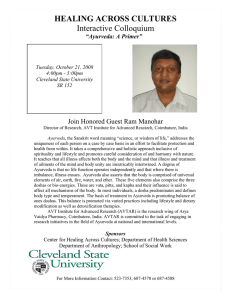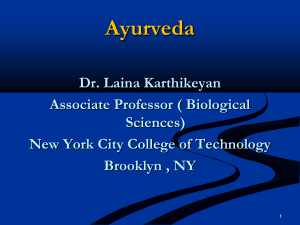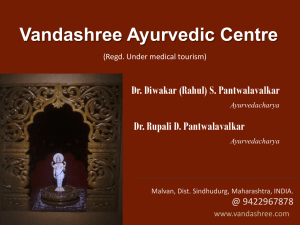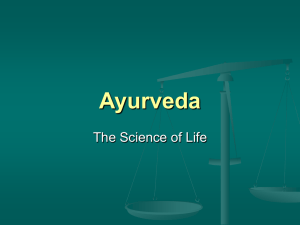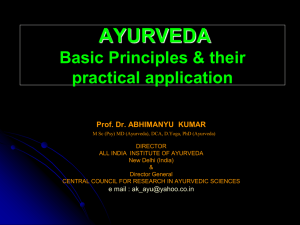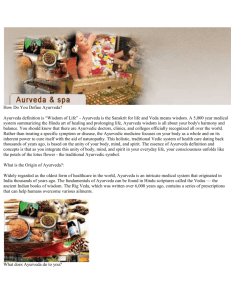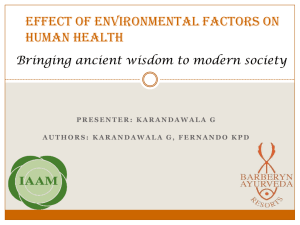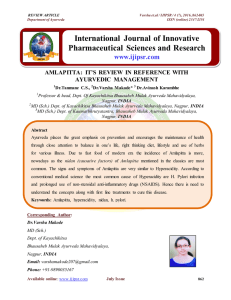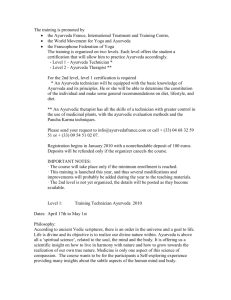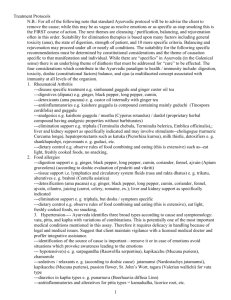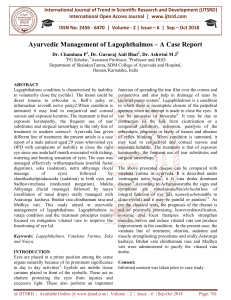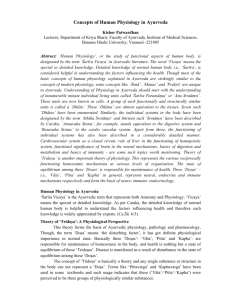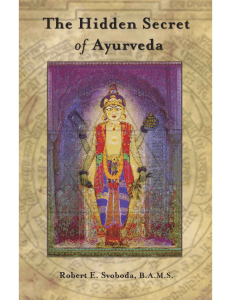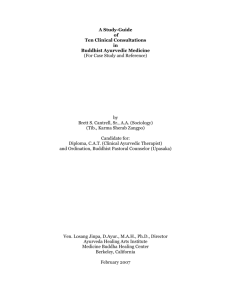Ayurveda - Basics
advertisement
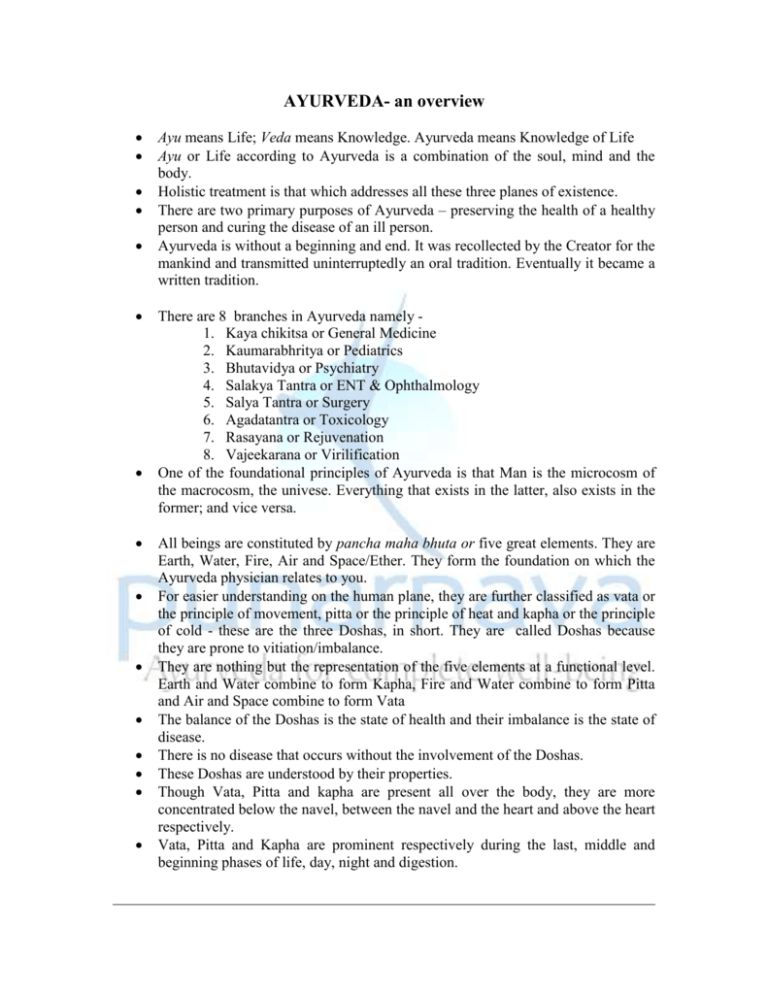
AYURVEDA- an overview Ayu means Life; Veda means Knowledge. Ayurveda means Knowledge of Life Ayu or Life according to Ayurveda is a combination of the soul, mind and the body. Holistic treatment is that which addresses all these three planes of existence. There are two primary purposes of Ayurveda – preserving the health of a healthy person and curing the disease of an ill person. Ayurveda is without a beginning and end. It was recollected by the Creator for the mankind and transmitted uninterruptedly an oral tradition. Eventually it became a written tradition. There are 8 branches in Ayurveda namely 1. Kaya chikitsa or General Medicine 2. Kaumarabhritya or Pediatrics 3. Bhutavidya or Psychiatry 4. Salakya Tantra or ENT & Ophthalmology 5. Salya Tantra or Surgery 6. Agadatantra or Toxicology 7. Rasayana or Rejuvenation 8. Vajeekarana or Virilification One of the foundational principles of Ayurveda is that Man is the microcosm of the macrocosm, the univese. Everything that exists in the latter, also exists in the former; and vice versa. All beings are constituted by pancha maha bhuta or five great elements. They are Earth, Water, Fire, Air and Space/Ether. They form the foundation on which the Ayurveda physician relates to you. For easier understanding on the human plane, they are further classified as vata or the principle of movement, pitta or the principle of heat and kapha or the principle of cold - these are the three Doshas, in short. They are called Doshas because they are prone to vitiation/imbalance. They are nothing but the representation of the five elements at a functional level. Earth and Water combine to form Kapha, Fire and Water combine to form Pitta and Air and Space combine to form Vata The balance of the Doshas is the state of health and their imbalance is the state of disease. There is no disease that occurs without the involvement of the Doshas. These Doshas are understood by their properties. Though Vata, Pitta and kapha are present all over the body, they are more concentrated below the navel, between the navel and the heart and above the heart respectively. Vata, Pitta and Kapha are prominent respectively during the last, middle and beginning phases of life, day, night and digestion. They make the digestive fire erratic, sharp and dull respectively by their dominance. They make the intestine dry (constipated), soft (loose) and normal by their dominance. The properties of Vata are – dry, light, cold, rough, subtle, mobile. The properties of Pitta are – slight unctuousness, sharp, hot, light, foul smell, flowing and liquid The properties of kapha are – unctuous, cold, heavy, dull, smooth, stable The similar properties cause an increase in the dosha and dissimilar properties cause a decrease in the dosha. The food that is consumed is converted in to two – the essence that is absorbed and the waste that is eliminated, The absorbed essence is known as rasa, which is the first dhatu (or the structural principle). The other dhatus are the blood, muscle, fat, bone, marrow and reproductive principle. The transformation at the dhatu level takes place uninterruptedly in a healthy person and ultimate energy (known as ojas) is generated as an end product. The waste for elimination are – feces, urine and sweat – these are called malas Thus are the foundational principles of Ayurveda – panchamahabhutas, doshas, dhatus, malas and agni (digestive fire) are the means through which the Ayurveda physician understands you and the state of your wellness better. A few more principles that you need to know include - Tastes and their effect on doshas – there are six tastes. They are sweet, sour, salt, pungent, bitter and astringent. Sweet, sour and salt increase kapha and decrease vata. Pungent, bitter and astringent decrease kapha and increase vata. Sour, salt and pungent increase pitta. Sweet, bitter and astringent decrease pita. Excessive, less and improper use of the sense organs, intellectual aberration and transformation that occurs with time are the three major causes of disease. A disease is understood by five factors – etiological or causative factors, prodromal symptoms, clinical features of the disease, pathogenesis and investigative therapies. A patient is examined in three ways – observation, palpation, interrogation. Diseases are classified in to two – curable and incurable. Curable diseases are either easily curable or difficult to cure. Incurable are either manageable or untreatable. Concept of “vega” – physical and mental urges. Physical urges – urge to pass wind upwards (belching) and downwards (flatus), stool and urine; sneeze, thirst, hunger, sleep, cough, exert ional heavy breathing, , yawning, tears, vomiting, semen. These urges should neither be controlled nor be forcefully initiated. Mental urges – greed, aversion, jealous, unhealthy competitive spirit etc. these urges should be always controlled. The vegas are an important concept in Ayurveda for we believe that many diseases have their origin in uncontrolled expression or suppression of the mental vegas and forced suppression of the physical vegas. Thus, using all the above principles, Ayurveda arrives at the definition of wellness as – Health is a state of bio-physical and physiological well being and a contented state of consciousness, senses and mind. In Ayurveda terms, this would mean - a state of balanced doshas, agni (digestive fire), dhatus, transformation, formation and elimination of malas (waste); a clear content state of the soul, sense organs and the mind. Ayurveda also understands the mind from the viewpoint of satva or a pure state, rajas or a pro-active state and tamas or an indolent state of the mind. Ayurveda believes that all diseases are psycho-somatic. What takes root in the mind affects the body also, and what takes root in the body affects the mind also. Ayurveda believes that if one is able to achieve a balanced state of satva, rajas and tamas with preponderance of satva, this would contribute significantly to wellness.
